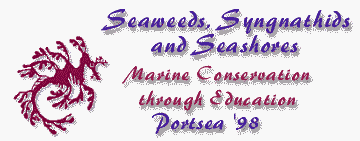 |
 |
Abstracts of Conference Papers
Bay Litter Watch or Down the Drain
Bob Winters
Education Programs Manager
Gould League of Victoria
Genoa St, Moorabbin
Vic. 3189Fax 03 9532 2860
Email: bobw@gould.edu.au
| In its dealings with litter education for older students, the Gould League has identified three areas requiring attention. Schools need to put into place appropriate litter management strategies, students need to become more motivated not to litter and they need to clarify some of their values that cause them to litter. |  |
The Gould League is gradually developing a number of litter education programs by focusing on the destruction of wildlife and degradation of habitats in catchments and the coastal environments.
What's wrong with litter in the bay and our other marine environments?
Litter can be a silent killer of our marine wildlife. It can choke an animal feeding on it, tangle and mangle many types of animals including dolphins, seals, penguins and many other birds. Over 50 kinds of seabirds are known to eat plastic and other litter. We only sometimes see the dead victims washed up on the beach. The sight of these injured dying animals is very upsetting. People can also be badly affected especially if they are unfortunate to step on very sharp litter.
Power boats have become stranded when litter has tangled the propeller and many boats have sunk when they have struck a large submerged object. Litter can last for a very long time in the environment before it eventually breaks down. In the sea, many objects can float a long distance fouling areas many kilometres from their source of litter.
Plastics in the marine ecosystem will last for many years. Wherever there are large quantities of litter on the beach, there are also likely to be other hidden and more difficult to detect pollutants in the water. The pollutants many of us are concerned about include oil, grease, heavy metals, fertilisers insect and weed poisons and E. coli bacteria. Other major contributions to the damage to our marine environment are from our pets. Each day many tons of dissolved dog droppings will end up in the sea creating major pollution problems.
Living In a Catchment
The Living in a Catchment program relates litter and the consequences of litter on the environment. By highlighting the environmental problems, students motivation not to litter will be increased. The themes of this program are litter prevention (rather than cleaning up) and the impact of litter on our immediate environment and its wildlife. Students are involved in half a day of indoor activities including designing litter traps. The half day of field work includes monitoring litter on beaches and measuring contaminants in a creek.
Bay Litter Watch is an Internet based campaign. The concept of this campaign is to capture students' interest in the environment without losing the litter message which could well be the problem with most litter programs designed to date. A campaign, directed at students, which can tie many of these issues together has all the ingredients of a successful litter education program. Extensive materials have been placed on the Internet with many links to other relevant sites. A printed summary is also available on request.
Program
 Students working in quadrats |
Using a kit developed and produced by the Gould League, a teacher and their students can visit their closest beach and survey the rubbish. The kit includes teaching activities that addresses litter and fits into the curriculum standards framework in Victoria. The survey is quite simple. Students measure four metres of string to create a one metre square quadrat. They place these one-metre quadrats every 5 or 10 metres along the highest tide line and the latest high tide line and count the rubbish, which will have mostly been washed in from the sea. Instructions include safety issues and students manipulating rubbish with a ruler. Results can be posted or using the specially designed web form, filled in on screen and automatically emailed. |
As part of the kit, students are encouraged to contact their local community newspaper and have them report on their activities. Some base information is provided so that students can determine just how much impact litter is having on the beach.
This program is initially directed at all schools near the bays (Port Philip and Western Port) and those visiting the bay.
The Internet Address for the Gould League and the Bay Litter Watch activity is